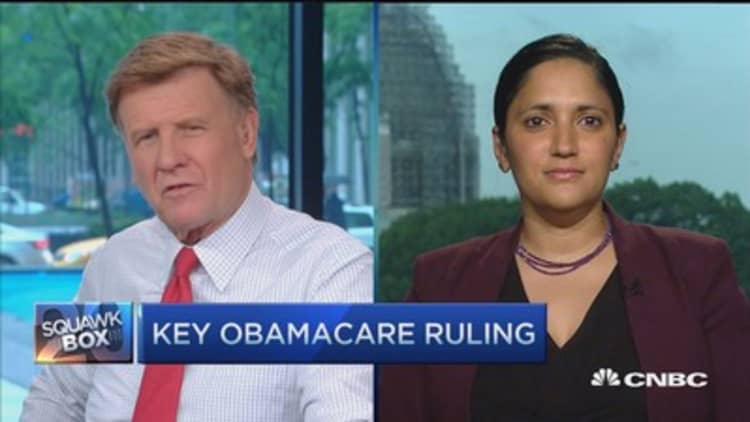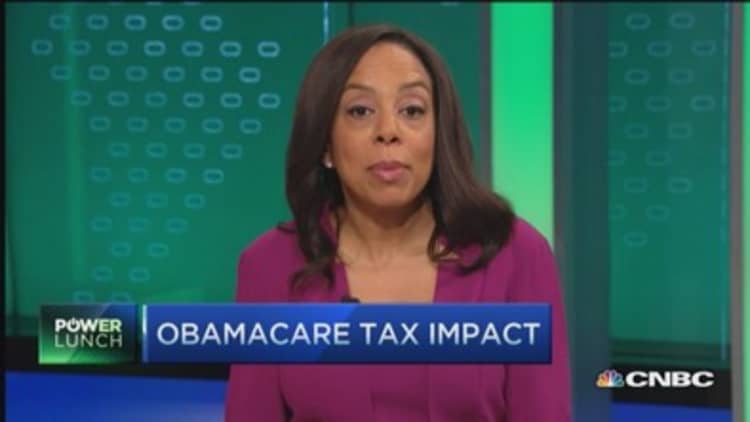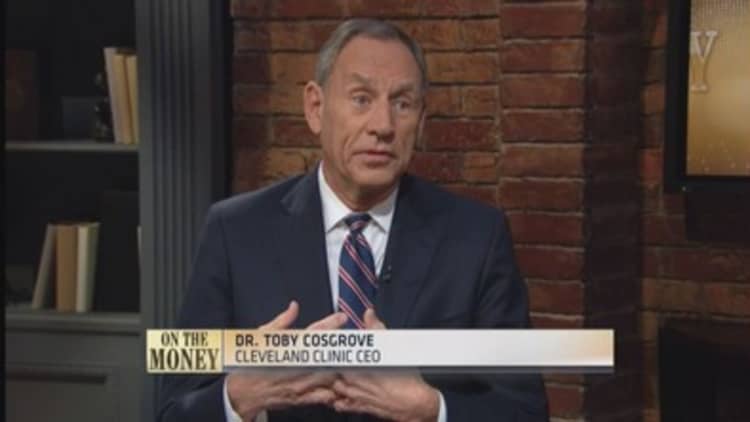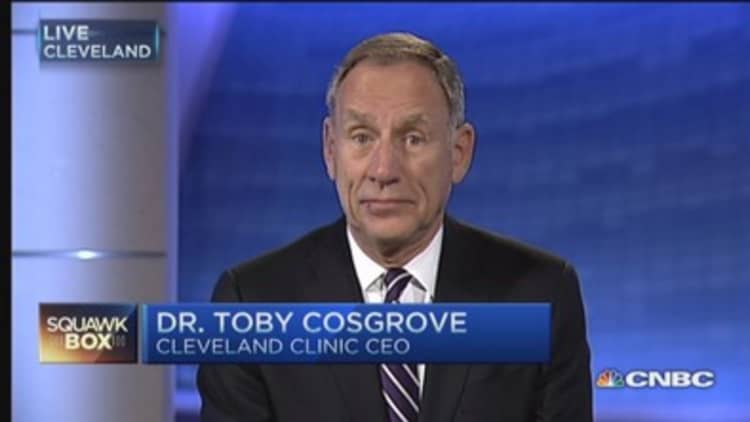



They're paid up—but many of them could soon lose their coverage.
A total of 10.2 million of the 11.7 million people who selected Obamacare plans for 2015 ended up paying for that coverage as of March 31, making their enrollment official, the federal government said Tuesday. (Tweet this)
For now at least, that tally surpasses the Obama administration's goal of retaining 9.1 million paid customers by the end of this year.
Total paid enrollment was split between 7.3 million people on HealthCare.gov, the federally run exchange whose platform serves 37 states, and 2.9 million people in exchanges served by individual states.
U.S. Health and Human Services Secretary Sylvia Burwell said the numbers show the exchanges are working as designed.
"Thanks to the Affordable Care Act, millions of Americans now rely on the health and financial security that comes from affordable coverage through the marketplaces. We've seen a historic reduction in the uninsured and consumers are finding the coverage they need at a price they can afford."
But the tally underscores a looming risk to Obamacare from a pending Supreme Court case, which threatens to eliminate the financial help that most people in ACA plans get in buying their plans.
About 85 percent—or almost 8.7 million—of all of the paying customers nationally qualified for federal tax credits that offset the price of their monthly premiums. Those subsidies worth an average of $272 per month are available to people with low or moderate incomes.
Most of the subsidized customers, 6.4 million people, have subsidized coverage through 34 of the states served by the federal exchange HealthCare.gov.
The Supreme Court is set to rule this month on whether financial aid to customers in those states is illegal. Plaintiffs in the case known as King v. Burwell claim the Affordable Care Act as written prohibits subsidies being granted to anyone other than customers of a state-established exchange.
If the Supreme Court ruled for the plaintiffs, it would end about $1.8 billion worth of financial assistance per month to customers in the affected states.
The ten states in the U.S. with the highest rates of customers receiving subsidies—above 90 percent in each state—are all served by HealthCare.gov. according to data released Tuesday.
Additionally, 60 percent of all enrollees in the affected states also receive so-called cost-sharing reductions, financial aid to offset the out-of-pocket expenses from deductibles, co-payments and co-insurance that customers have to personally pay when they get medical treatment. Those cost-sharing reductions, which are given to premium subsidy recipients who earn less than 2.5 times the poverty level, are also at risk from the King v. Burwell case.
"A victory for the plaintiffs in King v. Burwell could destabilize insurance markets in two-thirds of the states," said Obamacare expert Timothy Jost, a health law professor at Washington & Lee University.
Read MoreGOP's Obamacare 'fixes' have their own big risks
"Virtually all of the federal exchange enrollees receiving premium tax credits would be unable to afford coverage without those credits. Healthy enrollees would likely drop coverage, leaving a much higher cost group of enrollees behind. Insurers would have to raise premiums to cover them, making coverage unaffordable for all their enrollees."
The HealthCare.gov states with the highest numbers of subsidized customers are Florida with 1.32 million people, Texas with about 832,000 people, and North Carolina, with almost 459,000 subsidy-aided Obamacare customers.
Experts have predicted that up to 8.2 million people in HealthCare.gov states would drop their insurance coverage next year if the subsidies are ended. Those people would include non-subsidized customers whose premiums would become too pricey.
Ceci Connolly, Health Research Institute leader at PricewaterhouseCoopers, said "The numbers once again underscore the power of the subsidies—without them, far fewer Americans would have health insurance coverage."
"If the subsidies disappear, health-care providers face financial difficulties as well since we know that the uninsured often seek care at an emergency department regardless of whether they can pay," Connolly said. "Hospitals are worried about uncompensated care debt rising again to pre-ACA levels."
The 2.3 million people who received federal tax credits to help pay for insurance plans purchased on exchanges established by individual states would not be affected by the high court ruling. The lowest rate of subsidized paid Obamacare customers are seen among six states and the District of Columbia, which all run their own exchange.
The national total paid enrollment announced Tuesday represents about a 15 percent drop-off from the 11.7 million people who selected health plans sold on government exchanges during open enrollment for 2015.
Such drop-offs are the norm in the insurance industry, which regularly sees about 10 percent to 20 percent of would-be customers fail to pay their first month's premium after choosing a plan.
It is also common for some people to leave a plan during the year when they get coverage elsewhere, such as through a job, or drop their plans for other reasons. By the same token, people who have so-called life events, such as getting married, divorced, having a baby, losing a job, or moving to another state, are eligible to enroll in Obamacare plans during the year outside of open enrollment, which can offset some of the losses of customers.
At the end of last year, about 6.3 million people were paying for Obamacare. That's about 21 percent lower than the 8 million who had selected plans during open enrollment for that year, which had ended in the spring.
Before the start of open enrollment, Burwell said HHS had a target of 9.1 million enrolled Obamacare customers by the end of 2015.Burwell's target was on the low side of a range that HHS analyst had set. Those analysts projected that between 9 million and 9.9 million people would be paying Obamacare customers by the end of this year.
Burwell's announced paid enrollment target also was significantly less than the 13 million that had been projected by the Congressional Budget Office. The CBO in January lowered that projection to 12 million.
Read MoreWill these big Obamacare rates happen?
The lowered expectations reflect a realization among officials that signing up Obamacare customers after its debut in 2014 would be harder than in future years. Analysts noted that many of the customers last year were those who had been previously effectively priced out of the health insurance market because insurers were allowed to charge people with existing health conditions more than people without such ailments. The Affordable Care Act now bars insurers from that practice.
HHS, in a press release Tuesday, said the current paid enrollment tally "is consistent with meeting the department's goal for 2015 effectuated enrollment."


